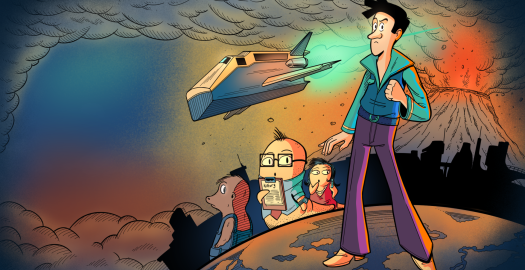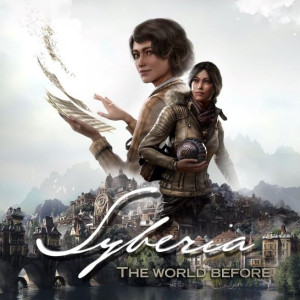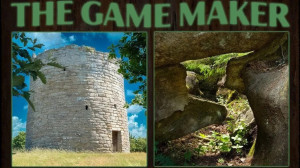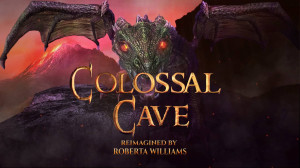Creating a Location in Captain Disaster and the Two Worlds of Riskara

Following in the wake of Captain Disaster in: The Dark Side of the Moon and Captain Disaster in: Death Has A Million Stomping Boots, the upcoming Captain Disaster and the Two Worlds of Riskara will continue the comedic, classic antics of its predecessors. Developer Dave Seaman writes below about the many decisions that sparked the creation of the vivid, stylized locales in this third entry in the series.
Background graphics have always been a vital component of adventure games, taking players to alien worlds, asteroids, and alternate realities as well as to real-life environments, pirate-filled islands, and the murky depths of the underworld. Although backgrounds are, by definition, not necessarily what stands out most when you're immersed in playing an adventure game, they are essential for creating memorable gaming experiences. We all have favorite scenes and locations from different games.
What, then, goes into creating these scenes? Designing them can be either effortless or challenging depending on the situation. Sometimes, the scene can be easily imagined or requires a specific layout to accommodate the puzzles planned for it. Other times, it takes a considerable amount of effort to come up with a design that really fits the game.
For instance, when Lorenzo Boni and I were planning the alien world featured in Captain Disaster and the Two Worlds of Riskara, we wanted a clear dichotomy between the two "worlds" contained on the planet - but I will only mention one, for fear of revealing spoilers.
Upon landing on the planet, we are greeted with a short cutscene of the Captain's spaceship, Disaster Area (yes, I unabashedly borrowed that phrase from a famous science fiction book), zooming through the ruins of a high-tech civilization. However, on landing, we are greeted with an entirely different environment - a far less technologically advanced race, but with certain similarities to what we as humans would be familiar with.

Echoes of a fallen civilization. Who were they, why did they fall, and what does it have to do with the mysteries that Captain Disaster will unearth?
The inhabitants of this planet are an alien race of slug-like creatures that are about a third of the height of humans. Due to their unique physiology, we decided to avoid using many straight lines and sharp angles in the buildings on this planet, particularly those that are currently in use by the inhabitants.

Some of the Art Nouveau-inspired architectural elements in the town feature the organic, curvy, natural forms typical of that style -- including the lamp and the chimneys.
Our goal was to create a stark contrast between the enormous, rational buildings that were once emblematic of a high-tech civilization and that now lie in ruins, and the part of town you are visiting, which grew organically around the remnants of the previous civilization.
When designing the buildings on the planet, we aimed for a bright and lively feel, using mainly pastel colours but also incorporating some bold hues to contrast with the cold and metallic skyscrapers. As I did not have much knowledge about architecture, I researched multiple styles until I found one that aligned with my vision for the planet's structures. The colour palette was also an important factor in achieving the desired look.
I had initially thought of using a combination of neoclassical architecture for the government buildings to give them an official look and Art Nouveau for the rest. Art Nouveau is known for its use of curves, asymmetrical designs, and shapes inspired by nature. We also wanted to avoid any similarities with well-known sci-fi building sets such as the igloo-shaped huts of Tatooine. Instead, we aimed for a homely, old-timey feel that would evoke a sense of comfort and familiarity.
Lorenzo used my sample photos to create a unique style for the buildings. He envisioned that the inhabitants of the planet created their homes and stores by incorporating elements from the previous civilization. As a result, you might come across a Doric column next to an Art Nouveau-inspired window or an Old West-looking wooden patio. This creative approach resulted in a diverse and fascinating architecture.

Even in poorer parts of the town, you can still see the curvy nature of the architecture in the roofs, plus some of the eclectic choices of the inhabitants, such as the columns at the top of the book shop. The city has been constructed using pieces from different eras, which we have tried to convey through these choices.

The shop interiors, including abandoned shops like this one, have a more utilitarian look to them, showing the pragmatic nature of the inhabitants.
By the end, what we have for the town is a mixture of various architectural styles from different times, resulting in an eclectic fusion of designs. However, we hope it's not an unpleasant one. As you progress, the storyline will gradually unfold, and you will come to understand why these choices were made and how they perfectly fit into the game. We are putting a great deal of effort into ensuring that everything aligns with the internal logic of the game world. Therefore, if anything appears illogical, it's likely just in your mind - at least that's the response we'll be sticking to!

The interiors of the government buildings, instead, tend towards a grand, neoclassical style, juxtaposed with technology far in advance of the current inhabitants. We chose neoclassicism because it often has been the go-to style for "important" constructions in the XVIII and XIX centuries, so the association with government building is an easy one to make.
As to the other "world" you will encounter in the game? You'll have to wait and see when the game is finished!







__medium.jpg)






